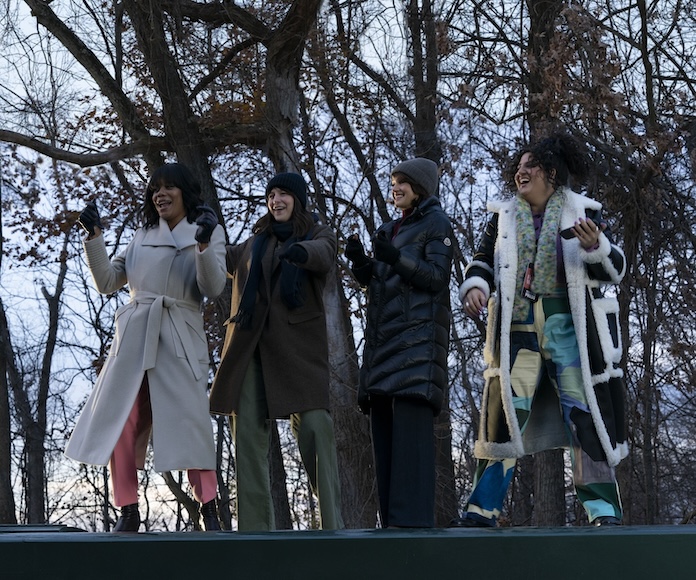
The Girls on the Bus
Max, March 14, 2024
Mar 12, 2024
Photography by Nicole Rivelli/Max
Web Exclusive
![]()
The timely The Girls on the Bus is a political drama focused on four women, of different generations, covering the race for the White House on the campaign trail for the Democratic National Convention from varying perspectives for dramatically divergent outlets. The 10-episode series is based on co-creator and writer Amy Chozick’s 2018 memoir about her experience reporting on Hillary Clinton’s campaign for presidency, Chasing Hillary.
The central girl is millennial Sadie (Melissa Benoist, Supergirl, Glee), a passionate young journalist clinging to the old school ways and writing for a legacy print newspaper. She has imaginary conversations with her writing guru, Hunter S. Thompson and real ones with her mentor and editor, Bruce (Griffin Dunne). Sadie has an alcohol-heavy relationship with Gen Xer Grace (Carla Gugino), a successful, experienced and cutthroat journalist, wife and mother of a college-bound daughter who could be a crystal ball into Sadie’s potential future. Lola (Natasha Behnam) is a borderline socialist Gen Z Iranian American influencer with “more followers than the Washington Post” who is doing things in an uber-modern way with sponsors paying for her every move and streaming her experiences live. Lola has major disdain for everyone around her, spouting a stream of woke-isms instead of actual sentences. Then there’s Kimberlyn (Christina Elmore, The Last Ship, Insecure) a determined Black centrist conservative reporter for a right-wing news platform. Kimberlyn’s smooth exterior barely hides her struggles to balance her personal and professional life. At the same time, she deals with judgements from her fellow journalists at every turn.
In the pilot, Sadie comes across as extra and trying too hard to be zany and clever, her idealism coloring her objectivity. Her friendship with Grace has a clique-y feel to it, the two of them stopping at nothing to get the inside scoop. In contrast, Lola has a false sense of power because of her massive following, but quickly discovering that real journalism is more complicated and the issues more layered than her surface-level understanding of politics and economics. Kimberlyn proves to be the most sympathetic character. She is blocked not just by her democratic counterparts, but also her coworkers who turn her excellent journalism into a comedy routine.
As the series moves along, the well-cast actors nail their characters. Being with each other day in and day out, these women start supporting and taking care of each other. Their growing friendships feel natural and believable, despite their differences. In fact, their conflicting views but smart conversations is what keeps their interactions interesting.
The political intrigue is light, more fun than dark, but that’s not the point. The Girls on the Bus is about women who now have a seat on a bus that used to only transport men. The series’ title is a play on Timothy Crouse’s 1972 non-fiction book, The Boys on the Bus. It also draws from Hunter S. Thompson’s 1973 book, Fear and Loathing on the Campaign Trail ’72. In contrast, the male characters on The Girls on the Bus, even those who are potential presidential candidates and press secretaries/love interests, are secondary to the main throughline of these women’s careers and dynamic friendships.
The further The Girls on the Bus gets into its storylines, the more likeable the central characters become, and the more invested you become in what happens with them. The series kicks off with two episodes and will continue with one episode a week. (www.max.com/shows/girls-on-the-bus/)
Author rating: 6.5/10
Average reader rating: 6/10
Current Issue

Issue #72
Apr 19, 2024 Issue #72 - The ‘90s Issue with The Cardigans and Thurston Moore
Most Recent
- Premiere: Slow Joy Releases New Single and Video for “King Cowboy” (News) —
- Hovvdy (Review) —
- Descendents, Circle Jerks @ Brooklyn Paramount, NYC, April 13, 2024 (Review) —
- Bat For Lashes Shares a Cover of Baauer’s “Home” From Her New Album (News) —
- Premiere: Veronica Lewis Shares New Single “Disconnected” (News) —

Comments
Submit your comment
Commenting is not available in this channel entry.There are no comments for this entry yet.